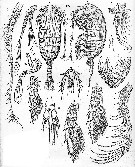|
|
 |
Fiche d'espèce de Copépode |
|
|
Calanoida ( Ordre ) |
|
|
|
Arietelloidea ( Superfamille ) |
|
|
|
Arietellidae ( Famille ) |
|
|
|
Sarsarietellus ( Genre ) |
|
|
| |
Sarsarietellus abyssalis (Sars, 1905) (F) | |
| | | | | | | Syn.: | Scottula abyssalis Sars, 1905 c (p.22, Descr.F); 1925 (p.338, figs.F, no M); Rose, 1933 a (p.243, figs.F, no M); Sewell, 1948 (p.505); Zaafa & al., 2014 (p.67, Table I, occurrence); | | | | Ref.: | | | Campaner, 1984 (p.107); Ohtsuka & al., 1994 (p.155, Rem.F, figs.F); Boxshall & Halsey, 2004 (p.63: fig.F) |  issued from : S. Ohtsuka, G.A. Boxshall & H.S.J. Roe in Bull. nat. Hist. Lond. (Zool.), 1994, 60 (2). [p.156, Fig.35]. Female (holotype, coll. Oslo, Norway): A, genital double-somite (ventral, part around copulatory pore missing); B, internal structure of right genital system; C, 4th endopod segment of Mxp (innermost seta indicated by arrowhead); D, 5th endopod segment of Mxp (innermost seta indicated by arrowhead); E, 6th endopod segment of Mxp. cd = copulatory duct; cp = copulatory pore; g = gonopore; rd = receptacle duct; o, oviduct; s, spermatothore remnant; sr = seminal receptacle. Scales in mm. Nota: Genital double-somite longer tyhan wide, its posterior end damaged, but single copulatory pore possibly present posteroventrally; anterior paired gonopores located ventro-laterally; copulatory duct heavily chitinized, divergent anteriorly, each connecting with elongate seminal receptacle with curved anteriorly and reaching to half length of somite with expanded bulbous part terminally. Mxp: 4th endopodal segment with relatively developed spinulose innermost seta, 5th segment fig.35D) also having spinulose innermost seta, but much shorter and thinner than on 4th segment: 6th endopodal segment (fig.35E) with seta a reduced, seta b over half length of medial-length seta c, medium-length spinulose seta c, spinulose seta d elongate
|
 issued from : S. Ohtsuka, G.A. Boxshall & H.S.J. Roe in Bull. nat. Hist. Lond. (Zool.), 1994, 60 (2). [p.157, Fig.36]. Female: A, A1 (segments XXI to XXVIII); B, terminal part of 2nd endopod segment of A2 (vestigial innermost seta indicated by arrowhead); C, exopod of A2: D, Md (mandibular endopod and exopod); E, praecoxal arthrite, coxal endite, basis and endopod of Mx1 (vestigial basal seta indicated by arrowhead); F, 1st praecoxal endite of Mx2; G, basal spine of Mx2; H, P5 (posterior). Scales in mm. Nota: A1 22-segmented; suture between segments XXIV-XXVI visible. First to eight (X) segments fringed with row of setules posteriorly. A2 endopod: 1st segment without inner seta; 2nd segment with 3 setae of unequal lengths medially0 and 5 setae and 1 vestigial seta terminally. Exopod indistinctly 8-segmented, 1st to 5th segments almost fused or incompletely fused, setal formula 0, 1, 1, 1, 1, 1, 0, 3. Md: gnathobase with 3 stout teeth, dorsalmost of which bifid at tip, lacking medial tuft of setules (as found in Crassarietellus sp.). Mandibular palp with endopod rudimentary, 1-segmented, with 2 setae of unequal lengths; exopod indistinctly 5-segmented, seta on 1st segment not reduced, outer seta on 5th segment relatively long. Mx1: praecoxal arthrite with 5 naked spines and 1 process; coxal endite carrying long serrate seta; coxal epipodite with 8 plumose setae; 2nd basal endite bearing 1 vestigial seta; endopod bulbous, 1-segmented, bearing 3 setae, one of which rudimentary. Mx2: 1st praecoxal endite with 2 spinulose setae and vestigial element; basal spine stout, bearing 2 rows of long spinules. P4 without inner coxal seta. P5intercoxal sclerite more or less fused; endopod almost fused with basis, medial suture visible; exopod separate from basis, indistinctly 3-segmented, sutures between segments visible, terminal outer spine almost fused with segment
|
 Issued from : G.O. Sars in Résult. Camp. Scient. Prince Albert I, 69, pls.1-127 (1924). [Pl.CXXII, figs.1-14]. As Scottula abyssalis. Female: 1, habitus (dorsal); 2, idem (lateral left side); 3, rostrum; 4, A1; 5, A2; 6, Md; 7, Mx1; 8, Mx2; 9, Mxp; 10, P1; 11, P2; 12, P4; 13, P5; 14, anal segment and caudal rami (dorsal).
| | | | | Ref. compl.: | | | El Arraj & al., 2017 (p.272, table 2, seasonal composition); | | | | NZ: | 1 | | |
|
Carte de distribution de Sarsarietellus abyssalis par zones géographiques
|
| | | | Loc: | | | NE Atlant. (Azores), off W Tangier (in Zaafa & al., 2014 (p.67)
Type locality: 38°37'N, 28°14'W | | | | N: | 4 | | | | Lg.: | | | (1) F: 3; {F: 3,00} | | | | Rem.: | After Ohtsuka & al. (1994, p.155) Sars (1924, 1925) overlooked the vestigial seta on the 2nd endopodal segment of A2, the rudimentary 1-segmented mandibular endopod with 2 setae, and the rudimentary seta on the 2nd basal endite of Mx1. The terminal segments of the female A1 were re-examined, revealing that there were several misinterpretations of the segmental fusion pattern and setation in Sars' descriptions. For the authors the Sars' male (1924, Pl. CXXII, fig.15) is attribuated to the genus Crassarietellus as Crassarietellus sp. | | | Dernière mise à jour : 25/10/2022 | |
|
|
 Toute utilisation de ce site pour une publication sera mentionnée avec la référence suivante : Toute utilisation de ce site pour une publication sera mentionnée avec la référence suivante :
Razouls C., Desreumaux N., Kouwenberg J. et de Bovée F., 2005-2025. - Biodiversité des Copépodes planctoniques marins (morphologie, répartition géographique et données biologiques). Sorbonne Université, CNRS. Disponible sur http://copepodes.obs-banyuls.fr [Accédé le 20 octobre 2025] © copyright 2005-2025 Sorbonne Université, CNRS
|
|
 |
 |






